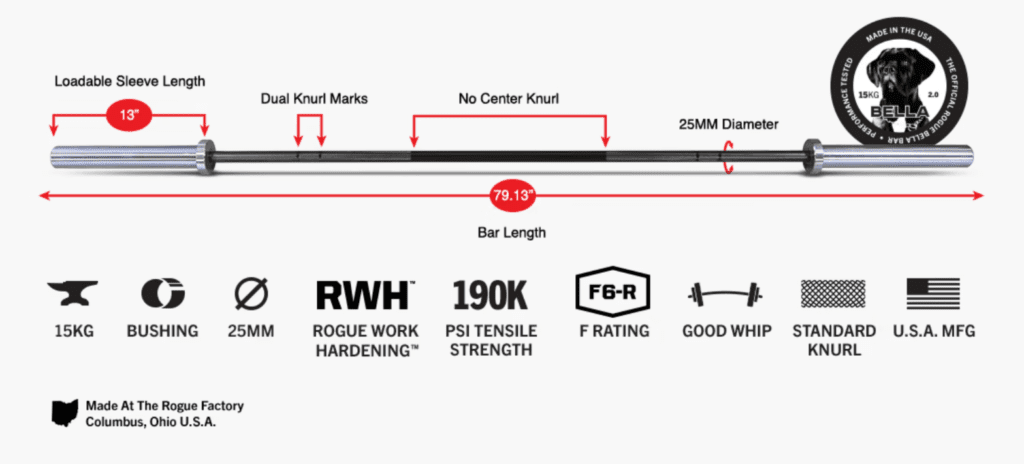Barbells, right? They’re the backbone of any strength training routine, letting you tackle everything from squats to Olympic lifts.
But here’s something you might not know: not every barbell is the same. There’s a real difference between men’s and women’s Olympic barbells.
In this article, I’m going to walk you through what sets these barbells apart.
We’ll look at what a women’s barbell is, why they’re a thing, and the main differences between men’s and women’s bars.
Let’s get started!
On This Page
Key Takeaways
| Key Takeaways | Details |
|---|---|
| What is a Women’s Barbell? | A 15kg/33lb barbell with a 25mm shaft diameter, designed for female anatomy and strength levels. |
| Why Women’s Barbells? | To accommodate smaller hands, less upper body strength, technique optimization, and injury reduction. |
| Differences from Men’s Barbells | Lighter weight (15kg vs. 20kg), thinner shaft (25mm vs. 28mm), less aggressive knurling, shorter length, and lower weight capacity. |
| Who Should Use Women’s Barbells? | Not just for women: beneficial for anyone needing a lighter, thinner bar, including men, youth, and elderly lifters. |
| Where to Buy Women’s Barbells | Top brands include Rogue Fitness, Bells of Steel, Synergee, Fringe Sport, and Get Rx’D. Prices range from $300 to $500. |
What is a Women’s Barbell?
A women’s barbell is a version of the standard Olympic barbell designed specifically for female athletes.
It weighs 15kg/33lbs instead of the typical 20kg/44lbs of a men’s Olympic bar. The shaft diameter is also smaller at 25mm vs. 28mm.

Women’s bars are optimized for the female anatomy and common issues that female lifters face when using standard men’s bars.
The lighter weight and thinner shaft allow women with smaller hands and less upper body strength to grip and control the bar more easily.
Why is there a Women’s Barbell?
There are a few key reasons why women’s barbells exist:
- Smaller Hands – The average woman has smaller hands than the average man. A thinner 25mm shaft is easier to grip for smaller hands.
- Less Upper Body Strength – Women on average have less absolute upper body strength than men. A 15kg/33lb bar is easier to control for those with less upper body strength.
- Technique Issues – The thicker 28mm men’s bars can cause issues like excessive elbow flare during presses for some women. A thinner shaft helps optimize technique.
- Injury Risk – Snatching and cleaning heavier 20kg/44lb men’s bars can increase injury risk for some female lifters due to the impacts. A lighter 15kg/33lb bar helps reduce this risk.
- Confidence – Many women feel more confident starting out lifting with a bar that’s optimally sized for their bodies. This leads to better training adherence.
Women’s barbells account for common differences in female anatomy and strength levels compared to male lifters. This helps female athletes lift safely and with better technique.
What’s the Difference Between a Men’s and Women’s Barbell?
There are a few key differences between a standard men’s Olympic barbell and a women’s version:
| Feature | Men’s Barbell | Women’s Barbell |
|---|---|---|
| Purpose | Designed for male athletes and maximum weight lifting capacity. | Designed for female athletes and optimized for female-specific needs. |
| Knurling | Aggressive knurl for secure grip on heavy lifts. Center knurl for squats. | Less aggressive knurl is easier on hands. No center knurl. |
| Weight | 20kg/44lbs | 15kg/33lbs |
| Weight Capacity | 700 lbs+ | Typically 300-500 lbs |
| Length | 7.2ft/2.2m | Typically 7ft/2.1m |
| Sleeve | Long loadable sleeves fit more plates | Shorter sleeves optimized for smaller plates |
| Shaft Diameter | 28-28.5mm | 25mm |
So in summary, the women’s bar is lighter, and shorter, has a thinner shaft, less aggressive knurl, no center knurl, shorter sleeves, and a lower weight capacity.
RELATED – Barbell Length – Choose The Right Size For You!
Who Can or Should Use a Women’s Barbell?
While called a “women’s barbell”, female athletes are not the only ones who can benefit from using this specialized barbell:
- Women of all ages and abilities
- Teenage girls
- Smaller framed men
- Men rehabbing injuries
- Youth and teen athletes
- Elderly lifters with grip issues
- Any athlete with small hands
- Those struggling with technique using a thicker bar
So while made more for women, anyone who may benefit from a lighter-weight and thinner-shaft barbell can consider the women’s bar.
Interested male lifters shouldn’t be afraid to give it a try.
You can also check out the best Olympic Weightlifting barbells overall, here.
Where To Purchase a Great Women’s Barbell
When equipping a home or garage gym, it’s worth investing in a high-quality women’s barbell if female athletes will be training.
Some of the top women’s barbells on the market include:
- Rogue Fitness Bella Bar 2.0
- Bells of Steel Women’s Barbell 2.0
- Synergee Regional Barbell
- Fringe Sport Women’s Wonder Bar V2
- Get Rx’D Stealth Bar
Be sure to purchase from a reputable brand that stands behind their products with a full warranty. Expect prices between $300 to $500 for a high-end women’s Olympic barbell.
For more advice on choosing a barbell, check out our barbell buying guide.
Frequently Asked Questions
Conclusion
Women’s barbells provide distinct advantages for female athletes over standard men’s bars.
The lighter 15kg/33lb weight and thinner 25mm shaft cater to smaller hands and reduced upper body strength compared to male lifters.
While made for women, any athlete who may benefit from a thinner and lighter bar should try out a women’s barbell.
Just be aware they may be hard to find. Any female strength athlete is encouraged to take a women’s barbell for a spin to experience the benefits first-hand.
Until next time,
-Dante